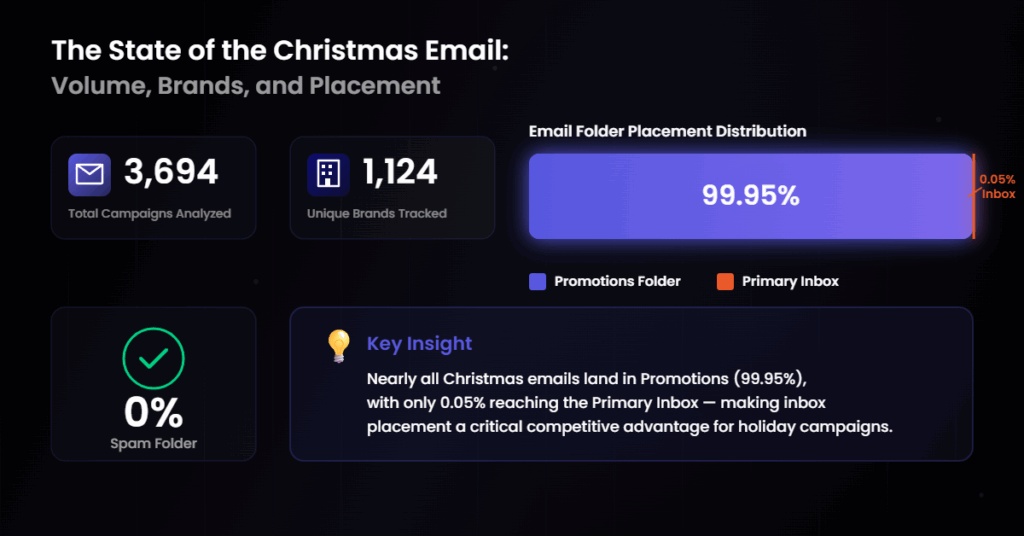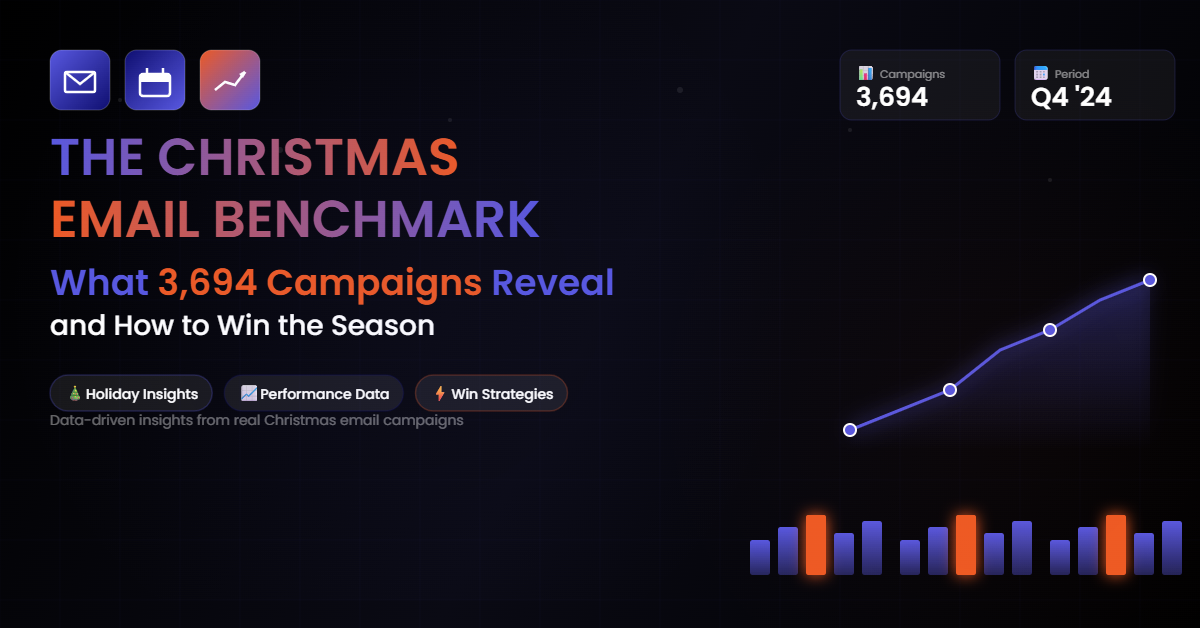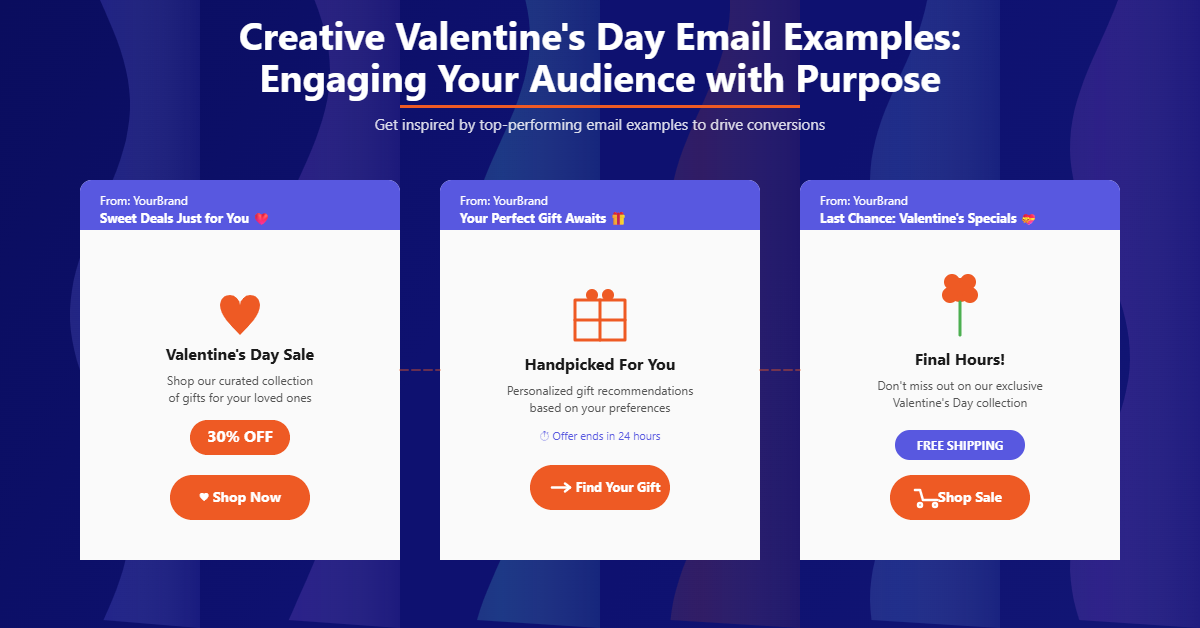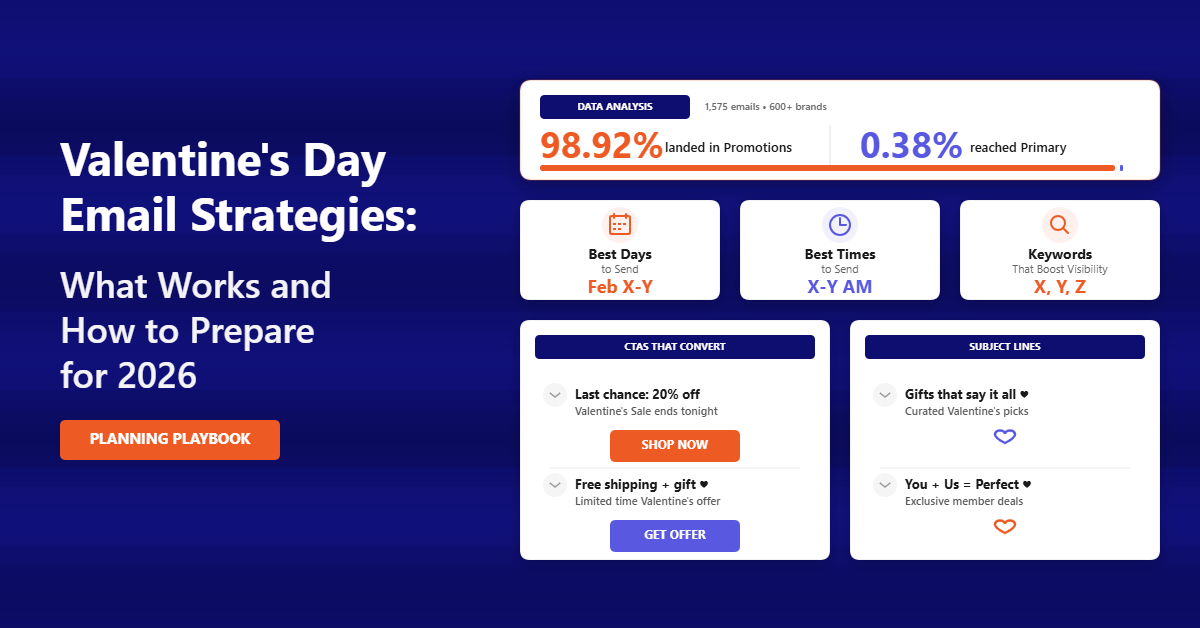Quick Summary
📮 Email Placement Matters: 99.95% of Christmas emails went to Promotions, requiring brands to stand out there.
🔁 Sequenced Emails Drive Revenue: Brands sending multiple emails see better results than those sending just one.
⏰ Timing is Key: Sending emails during off-peak times can help brands avoid crowded inboxes.
🧩 Personalization Opportunity: Only 1.92% of emails used first-name tokens, leaving room for more tailored content.
🎯 Clear, Specific CTAs Work: Outcome-focused CTAs like “Get it by Friday” are more effective than generic ones.
In an analysis of 3,694 Christmas email campaigns from 1,124 brands, a staggering 99.95% of messages landed in the Promotions tab, only 0.05% cracked the primary inbox, and none hit spam.
That means the Christmas email isn’t fighting to avoid the junk folder; it’s competing for attention in a crowded marketplace where relevance, timing, and clarity determine who gets the click.
The State of the Christmas Email: Volume, Brands, and Placement

Holiday inbox in 2024 saw 3,694 Christmas email campaigns from 1,124 brands, confirming that retailers continue to rely heavily on email to drive seasonal revenue.
While the sheer volume is unsurprising, the folder placement is more revealing. Just 0.05% of messages reached the primary inbox, and 99.95% went to Promotions, with 0% flagged as spam.
Unlike the primary inbox, Promotions placement is a different battlefield. The Promotions tab is a curated storefront where customers scan for value, relevance, and urgency.
The task is to be the best offer in view. That forces sharper copy, clearer CTAs, stronger visuals, and message continuity across the season.
How Brands Set Their Cadence: One-and-Done vs. Consistent Touches
A meaningful pattern emerges in send frequency. 42.5% of brands sent just one Christmas email. About a quarter sent four.
The rest is split between two and three messages.
In other words, most brands either made a single move or committed to a short, purposeful sequence.
One-off bursts rarely match the revenue impact of a well-timed sequence.
A four-touch plan, teaser, main offer, shipping deadline push, and last-chance digital gifts cover the full buying cycle.
It also reduces pressure on any single send and allows you to shape urgency as the calendar tightens.
If you’re worried about fatigue, narrow sends to engaged segments and throttle cadence by activity or loyalty tier.
Timing Strategy: The Most Crowded Days and Hours
The most active campaign days clustered around December 12, 13, and 11, with a secondary surge on December 6 and 16 and a strong showing on December 10.
Peak send hours were equally concentrated: 2 p.m., 3 p.m., 4 p.m., 1 p.m., and then 11 a.m. and 6 p.m.
This concentration reveals a simple opportunity. If most brands show up midday, try beating the rush or owning off-peak moments.
Early morning sends catch commuters and planners. Evenings capture couch shoppers. Weekend mornings can perform well for gift guides and bundles. Layer in GEO timing to match local lunch breaks and after-work windows.
And when you do send during peak hours, choose a distinctive hook so your Christmas email earns attention in a crowded slot.
More Christmas Email Marketing Resources for You
Subject Lines That Cut Through: Discounts Dominate, Emotion and Gifting Lag
Discount-driven subject lines ruled the season, accounting for 32.34% of sends. Gifting-focused lines represented 11.45%, and emotional or seasonal tones trailed at 8.55%.
Almost half (47.65%) fell into neutral or undefined styles, a missed opportunity given the clutter in Promotions.
Discounts will always move the needle, but your Christmas email gains an extra edge when the subject line ties saving to relevance.
“20% off” is generic; “20% off last-minute gifts under $50” helps the shopper “do” something.
Pair offer language with helpful intent or emotion: help me choose for him, solve for shipping cutoffs, or make me feel festive and confident. Each small layer increases the chance of the open in a Promotions-dominant world.
Short, specific, and human works best. Add pre-header copy that completes the thought, not repeats it.
For example, a subject line like “Gifts they’ll actually use” pairs with “Top-rated picks ship free by Friday” to deliver both intent and deadline.
Personalization Is Practically Untapped—And That’s Your Edge
Only 1.92% of campaigns used a first-name token, and 98.08% were not personalized. That’s a near-universal gap.
Personalization goes beyond a greeting. For a Christmas email, the highest-impact moves are dynamic merchandising and behavior-aware copy.
If someone browses men’s accessories, show men’s gifts first.
If a shopper’s lifetime value is high, lead with VIP perks or early access.
If a customer frequently buys for kids, open with family bundles and gift guides.
Personalized blocks make the body of the email feel relevant without overhauling the main creative each time.
For brands using TargetBay Email & SMS, dynamic content and audience rules make it straightforward to tailor sections by category preference, loyalty tier, or onsite behavior, all while your AI email agent speeds up versioning and QA.
The data shows most brands aren’t doing this; your reward for investing here is outsized.
CTAs and Creative: Stop Saying “Shop Now” 280 Times
The most common CTA was “shop now,” used 280 times.
“Shop,” “learn more,” “clearance,” “deals,” “shop men,” “buy now,” “Shop for the Holidays,” and “Shop Women” followed at much lower counts.
Clear CTAs matter, but repetition dulls their effect when customers scan quickly.
Shift from generic to guided action. Make CTAs promise outcomes and reduce decision friction.
“Get it by Friday,” “See top-rated gifts,” “Find her gift,” “Finish your list,” or “Grab stocking stuffers under $25” help shoppers immediately translate intent to click.
If you collect product reviews, highlight star ratings next to featured items and link to “See why 1,200+ shoppers love it.” Social proof cuts bounce rate and shortens the path to purchase, and it’s easy to implement with TargetBay Reviews.
CTA placement matters as much as wording. Place a primary CTA above the fold and include secondary, more specific CTAs further down.
Align each with the content block it supports, one for a bundle, one for a category, one for gift cards.
That way, the visitor who scrolls finds something made for them rather than another bland “shop now.”
Designing for the Promotions Tab: The Storefront Mindset
If nearly every Christmas email lands in Promotions, design accordingly. Think storefront, not letter.
Lead with a compelling hero that clarifies the offer and the why. Use scannable modules that organize by recipient intent, gifts by price point, gifts by recipient, bestsellers, and last-minute options.
Include shipping or curbside deadlines in the header to set urgency without shouting.
Preview text and the first two lines of body copy carry extra weight because Gmail surfaces them in the card preview.
Make those lines work hard. If your brand uses loyalty rewards, pull a “You have 800 points—save $8 today” teaser into the header to anchor value from the start.
With TargetBay Rewards, it’s simple to show available points and nudge redemptions while still promoting paid offers.
A Four-Email Sequence That Matches Real Shopper Behavior
A strong seasonal plan uses four emails that map to the buyer’s journey and the calendar.
Start with a teaser the first week of December to set the theme and value proposition.
Use a subject like “Your holiday shortlist is here” with preheader copy that mentions price tiers or curated collections.
Keep the tone warm and helpful, and invite a quick browse rather than pushing a hard discount.
Follow with a primary offer around mid-December, but consider sidestepping the most crowded days of December 11–13 unless you have exceptional creative or a unique angle.
A Tuesday morning send or a Thursday evening slot can perform well against the midday surge.
Highlight bundles, top-rated items, and gifts by persona. Reinforce credibility with review snippets sourced via TargetBay Reviews to reduce hesitation.
As carrier deadlines approach, push urgency with clarity, not panic. Use a subject like “Order by Wednesday for guaranteed delivery” and place the deadline near the top of the email.
Offer alternatives like in-store pickup or digital gift cards, and feature ready-to-ship items prominently. GEO-target deadlines by region when possible so your message reflects reality, not a generic cutoff.
Close with a last-chance message focused on digital gifts, memberships, or instant delivery after shipping windows pass.
Keep the tone optimistic—“You’re not late; you’re smart”—and make CTAs obvious.
If you run a loyalty program, add a gentle reminder to redeem points on gift cards or experiences to drive incremental AOV.
Send-Time and Daypart Testing: Beat the Crowd Without Guesswork
The busiest hours were 1 to 4 p.m., with 2 p.m. as the peak. That tells you where competition is strongest.
Counter-program with early morning, post-work evening, or late-night sends for specific cohorts like shift workers or parents shopping after bedtime.
Test Friday afternoon for last-minute shoppers and Sunday evening for planners.
Even small improvements in timing compound over a season. Segmentation by time zone ensures you don’t land at 2 a.m. and miss the morning scroll.
Automated experimentation through a platform like TargetBay Email & SMS lets you quickly adjust dayparts based on open and click velocity so your Christmas email meets each audience at the right moment.
More Christmas Email Marketing Resources for You
Deliverability and List Health: Promotions Isn’t the Problem—Irrelevance Is
With 0% spam placement and near-total Promotions routing, traditional deliverability concerns take a back seat to engagement quality.
Clean your list ahead of the holidays, suppress chronically unengaged contacts, and ramp up to higher volumes gradually.
Use hold-out groups to measure incremental lift from each send. If open rates slip, pivot subject line style before cutting volume, and refresh creative blocks that underperform instead of repeating the same hero and CTAs.
Quality signals also come from relevance. Send different versions to recent buyers versus lapsed customers.
Give VIPs first access and exclusive bundles. Reduce hero discounting for full-price shoppers and lead with value stories or product benefits.
The more relevant you are, the more Gmail rewards you receive within Promotions.
What This Means for Your Team
The data paints a clear picture: your Christmas email wins by combining a deliberate cadence, thoughtful timing, personalized merchandising, and CTAs that do more than shout “shop now.”
Be the most relevant option in a busy feed. Brands that lean on neutral subject lines and generic creative are leaving attention, clicks, and revenue on the table.
Design each send to help the customer finish a task. Make it easy to choose. Anchor urgency to real deadlines. Highlight social proof. Swap generic CTAs with outcome-focused ones. Spread your sends across less crowded days and dayparts, and keep your creative consistent enough to build recognition across the sequence.
Wrapping Up: Turn Seasonal Noise into Measurable Wins
The season rewards brands that respect how customers actually shop. Almost every Christmas email will land in Promotions, which is fine. That tab is where holiday intent lives.
What separates top performers is a smart sequence, a willingness to zig on timing when others zag, and a commitment to personalization that goes beyond a name token to show the right products to the right people at the right moment.
If you want a practical edge, unify messaging and motivation. TargetBay Email & SMS gives you the orchestration to build and personalize seasonal journeys fast, TargetBay Reviews supplies the proof shoppers look for in a crowded tab, and TargetBay Rewards turns every gift into a reason to come back.
With those pieces working together, your brand’s next Christmas email won’t just be seen, it will be chosen.






